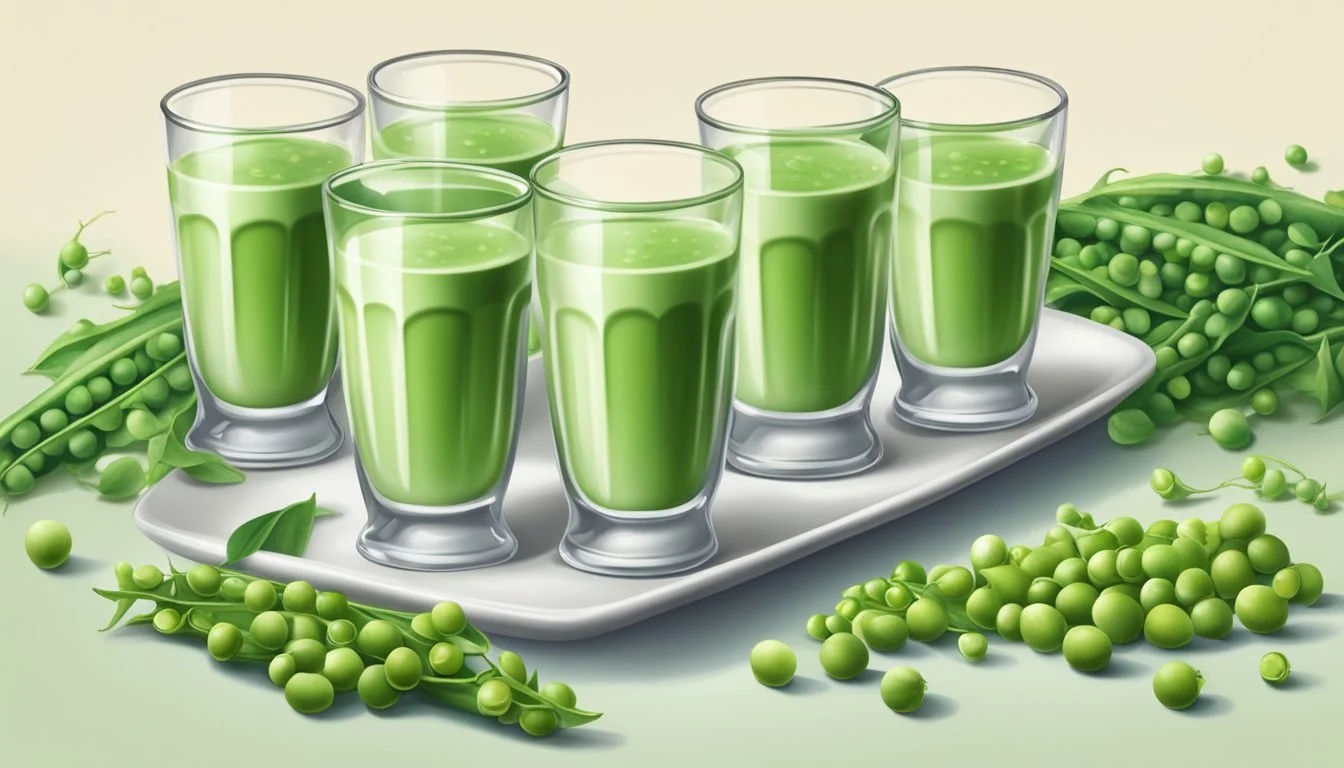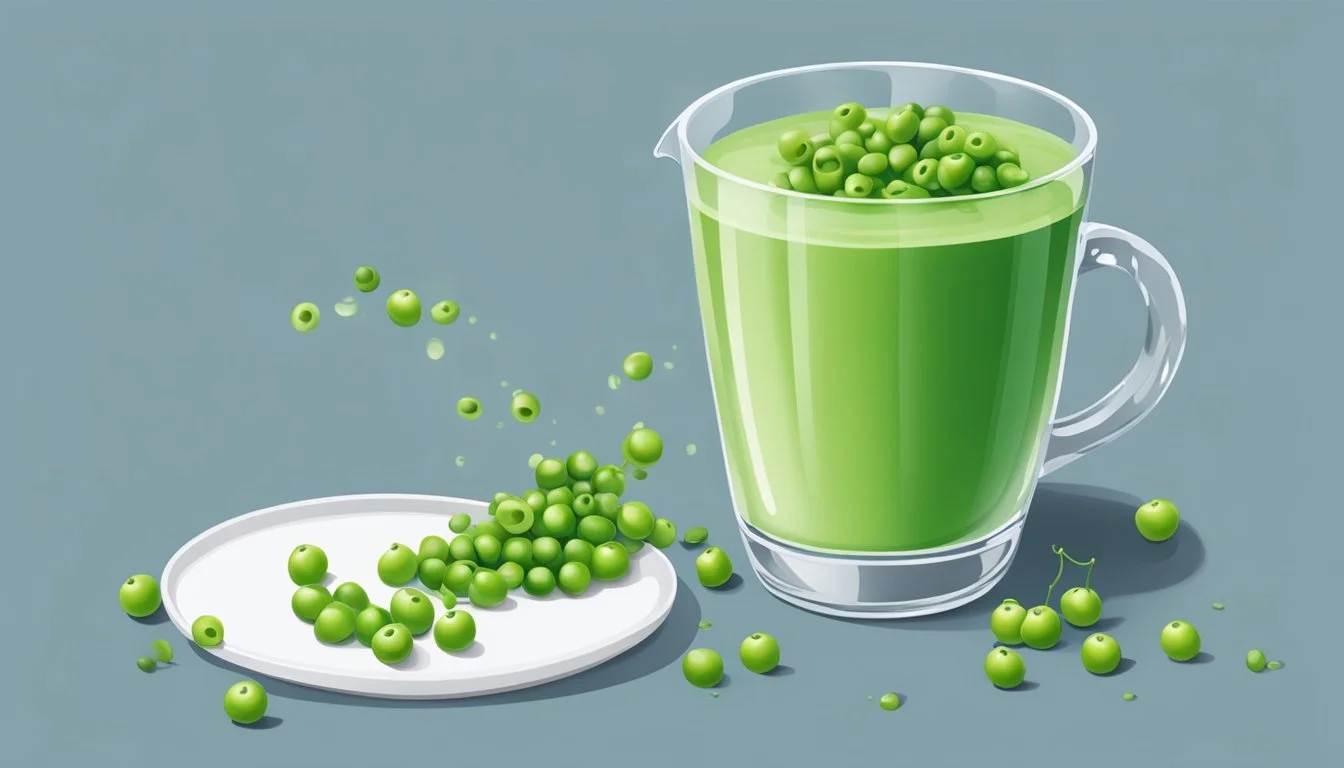How Many Servings of Pea Milk Is Too Much
Expert Insights
Pea milk has recently gained popularity as a nutritious alternative to traditional dairy and other plant-based milks. Its appeal largely lies in its impressive protein content, with unsweetened versions offering eight grams of protein per serving, comparable to cow's milk. Pea milk also boasts higher calcium levels due to fortification.
Yet, with any nutritious beverage, moderation is key. Consuming too much pea milk may lead to potential health concerns such as an imbalance in dietary fats or excessive calorie intake. While pea milk is low in saturated fat, it can be higher in omega-6 fats, which most people already consume in sufficient amounts.
Determining the right amount involves balancing it within an overall diet. Integrating a varied diet that includes different sources of plant-based proteins and nutrients ensures a well-rounded approach to nutrition.
Overview of Pea Milk
Pea milk is gaining popularity as a nutritious and allergy-friendly plant-based alternative to cow's milk. It offers a high protein content and is often fortified with important vitamins and minerals.
Definition and Origin
Pea milk is made from yellow field peas, not the green peas found in the grocery store. These peas are milled into flour, and the protein is extracted, purified, and blended with water and other ingredients to create the milk. This process results in a smooth, creamy texture. Unlike some plant-based milks, pea milk does not rely on soaking, making it unique in its manufacturing process.
Comparison with Other Plant-Based Milks
Pea milk stands out for its protein content, offering around 7-8 grams per serving, which is similar to cow's milk. Soy milk also has high protein, making these two options particularly good for protein intake. Almond, oat, and coconut milks tend to have lower protein levels but offer different benefits, such as taste and other nutrients.
Pea milk is also free from common allergens like nuts and soy, a notable benefit over almond and soy milks. Oat milk is another allergen-friendly option but typically has less protein.
Nutritional Profile
Pea milk is fortified with nutrients such as calcium, vitamin D, and iron. A serving usually provides 7-8 grams of protein and around 100 calories. It also offers 150% of the calcium found in cow's milk. This makes it a nutrient-dense option compared to other plant-based milks, which may vary significantly in their nutritional content based on brand and added ingredients.
Pea milk's nutritional strengths make it particularly appealing for those seeking a balanced and nutritious alternative to dairy. It combines protein richness with essential vitamins and minerals, making it a strong competitor in the plant-based milk market.
Health Implications of Pea Milk Consumption
Pea milk is becoming popular among consumers looking for dairy-free and nutritious alternatives. It offers several health benefits, particularly for those with lactose intolerance, while being rich in essential nutrients and having potential digestive reactions worth noting.
Benefits for Lactose Intolerance
Pea milk stands out as an excellent choice for people with lactose intolerance. As a plant-based milk, it contains no lactose, making it a suitable option for those who cannot digest lactose found in cow's milk. This feature helps prevent symptoms such as bloating, cramps, and diarrhea that are commonly associated with lactose intolerance.
Additionally, pea milk is also beneficial for people with specific allergies, like soy or nut allergies, providing an alternative they can consume without adverse reactions.
Nutrient Content and Health Benefits
Pea milk is rich in various nutrients that contribute to overall health. A single serving provides 7-8 grams of protein, more than most other plant-based milks. It contains significant amounts of calcium, vitamin D, iron, and potassium, making it a nourishing choice.
For example, one cup of pea milk has more calcium than cow's milk and 150% more than the recommended daily intake. These nutrients promote strong bones, muscle function, and overall body health, making pea milk a powerful supplement to a balanced diet.
Possible Digestive Reactions
While pea milk is generally well-tolerated, some people might experience digestive reactions. For example, its fiber content is typically low, but the addition of certain ingredients like sunflower oil can cause gastrointestinal discomfort in sensitive individuals.
It's also important to be mindful of added thickeners or stabilizers present in some commercial brands. These can sometimes lead to bloating or digestive distress. Monitoring these reactions can help consumers determine the best amount and type of pea milk to include in their diet.
Dietitian Recommendations
Nutritionists and dietitians widely recommend pea milk for its balanced nutritional profile. The Academy of Nutrition and Dietetics highlights its high protein content as a significant advantage over other plant-based milks. Unlike almond or cashew milk, pea milk contains essential amino acids comparable to cow's milk.
Experts suggest incorporating pea milk into a balanced diet, particularly for those seeking dairy-free or vegan alternatives. They advise starting with one to two servings per day, then monitoring the body's response, ensuring it fits well with individual dietary needs and preferences.
Pea Milk Dietary Considerations
Pea milk offers several benefits and is suitable for diverse dietary needs. It’s important to consider potential allergies, as well as its appropriateness for vegetarians and vegans.
Allergies and Intolerances
Pea milk is a valuable alternative for individuals with nut or soy allergies and those who are lactose intolerant. Unlike dairy milk, pea milk does not contain lactose, making it an excellent choice for those who experience lactose intolerance.
Moreover, pea milk is less likely to cause allergic reactions compared to nut-based milks such as almond or cashew milk. Soy allergies are also common, and pea milk provides an alternative for soy-intolerant individuals to receive comparable nutrients without adverse reactions.
However, individuals with pea or legume allergies should exercise caution and may need to consult with a healthcare professional before incorporating pea milk into their diet.
Suitability for Vegetarians and Vegans
Pea milk is entirely plant-based, making it a perfect option for both vegetarians and vegans. It provides a good amount of protein, with around 7-8 grams per serving, closely matching the protein content of cow's milk and surpassing that of almond or coconut milks.
Furthermore, pea milk is typically fortified with essential nutrients such as calcium and vitamin D, which are often lacking in vegetarian and vegan diets. This fortification helps vegetarians and vegans meet their daily nutritional requirements without relying on animal products.
Its suitability for these diets also means that pea milk can support a balanced and nutrient-rich diet for those avoiding animal derivatives, ensuring they receive vital nutrients like proteins and micronutrients.
Consumption Guidelines
When considering how much pea milk to consume daily, it is crucial to balance nutrient intake while adhering to dietary guidelines. This section focuses on determining the appropriate servings to maintain a healthier lifestyle.
Determining Appropriate Servings
The Dietary Guidelines for Americans suggest a varied diet, emphasizing the intake of diverse vegetables and plant-based proteins. Pea milk, rich in protein and other essential nutrients, can be a valuable part of this balanced diet.
Key considerations include:
Serving size: Typically, one cup of unsweetened pea milk provides about 8 grams of protein. This is similar to cow's milk.
Recommended intake: While there are no specific guidelines for pea milk, consuming 1-2 cups daily can complement your nutritional needs without overconsumption.
Nutrient distribution: Pea milk offers an advantage over other plant-based milks like almond and oat, which contain less protein and essential nutrients.
Individual dietary needs: Adjust servings based on personal dietary requirements, including overall intake of plant-based proteins and other nutrients.
Always consult dietary guidelines and consider individual health conditions when incorporating new elements like pea milk into your diet. A moderate and informed approach ensures nutritional benefits without excess.
Impact on the Environment
Pea milk offers notable environmental advantages compared to dairy and other plant-based milk alternatives. By utilizing yellow peas, this legume-based milk positively impacts sustainability and resource efficiency.
Sustainability of Pea Milk Production
Pea milk production is considered more environmentally friendly due to the modest agricultural demands of yellow peas. These legumes require less water and fertilizer compared to almonds, which are notorious for their high water usage.
Producing pea milk yields low greenhouse gas emissions. Peas enrich the soil by fixing nitrogen, reducing the need for synthetic fertilizers. Unlike dairy farming, which requires significant land and generates methane, pea cultivation is more sustainable.
Moreover, transportation of yellow peas is efficient due to their long shelf life and stability. This minimizes the carbon footprint related to logistics. Overall, pea milk is a compelling option for those seeking to reduce their environmental impact through diet choices.
Pea Milk in Culinary Uses
Pea milk is an adaptable ingredient in various culinary applications, fitting seamlessly into many recipes. Its texture and taste make it a viable alternative to cow's milk in numerous dishes.
Flavors and Recipe Integration
Pea milk comes in various flavors, including plain, vanilla, and chocolate. This variety allows it to be used in diverse recipes without compromising taste. For instance, vanilla pea milk can enhance the flavor of smoothies, oatmeals, and baked goods.
In savory dishes, plain pea milk serves as a neutral base for soups, sauces, and gravies. Its slightly sweet taste complements a range of ingredients, making it suitable for both sweet and savory applications. Additionally, its high protein content can improve the nutritional profile of any recipe.
Comparison in Texture and Taste to Dairy Milk
Pea milk has a creamy texture that is comparable to 2% dairy milk. This makes it an excellent option for recipes that require a thicker consistency, such as puddings, custards, and creamy pasta sauces. The added vegetable oils contribute to its creaminess, giving it a texture that many find pleasing.
Taste-wise, pea milk has a mild, somewhat sweet flavor. It lacks the strong nutty taste found in almond milk and the pronounced soy taste in soy milk. This neutral flavor allows it to blend seamlessly into recipes, enhancing the dish without overpowering other ingredients. While it is lower in saturated fats, it maintains a rich mouthfeel that many people enjoy.
Choosing the Right Pea Milk Product
Selecting the best pea milk involves looking at ingredient labels and considering the differences between fortified and naturally nutrient-rich options to ensure it meets dietary needs.
Understanding Labels and Ingredients
Reading labels on pea milk products helps identify key ingredients and added nutrients. Labels list the amount of protein, calcium, vitamin D, and other micronutrients.
Comparing brands:
Protein content: Pea milk often contains around 7 grams of protein per serving, comparable to dairy milk.
Added sugars: Look for unsweetened versions to avoid unnecessary calories.
Allergens: Pea milk is naturally dairy-free, nut-free, and soy-free, making it suitable for people with allergies.
Ingredient lists should be short and include recognizable components. Avoid products with long lists of preservatives or artificial additives.
Fortified vs. Natural Nutrient Content
Pea milk can be naturally nutrient-rich or fortified with additional vitamins and minerals.
Fortified pea milk:
Calcium: Often fortified to supply more calcium than cow's milk.
Vitamin D: Added to improve bone health.
Iron and Omega-3s: Some brands fortify with iron and omega-3 fatty acids for extra health benefits.
Natural pea milk:
Contains naturally occurring nutrients from peas, though levels might be lower than fortified versions.
Choosing between natural and fortified depends on dietary needs. For those with specific nutrient deficiencies, fortified pea milk can be beneficial. On the other hand, those seeking fewer additives might prefer natural options.
Common Consumer Questions
When it comes to pea milk, consumers often have questions about its potential impact on health and how it compares to other milk options.
Effects of Overconsumption
Consuming too much pea milk can have certain effects on the body. While it is rich in protein—8 grams per serving—overconsumption may lead to an excess intake of calories and nutrients like calcium and omega-6 fats.
High calcium levels could potentially cause kidney stones in susceptible individuals. Furthermore, while omega-6 fats are necessary, an imbalance between omega-6 and omega-3 fats can negatively impact the nervous system. Monitoring intake is essential to maintain a balanced diet.
Comparing Pea Milk to Dairy and Other Alternatives
Pea milk offers several benefits and differences compared to cow’s milk and other dairy alternatives such as almond, oat, and cashew milk.
Protein: Pea milk contains about 8 grams of protein per serving, comparable to cow's milk but significantly higher than most other plant-based options.
Calcium: Often fortified to provide up to 50% of the daily value per cup, making it competitive with dairy products in promoting bone health.
Saturated Fat: Lower in saturated fat compared to cow's milk, supporting wellness by reducing the risk of cardiovascular issues.
Taste and Texture: Pea milk is creamy, making it a versatile choice for recipes, unlike some thinner dairy alternatives.
It's also important to choose unsweetened versions to avoid added sugars, which can contribute to excess calorie consumption.









